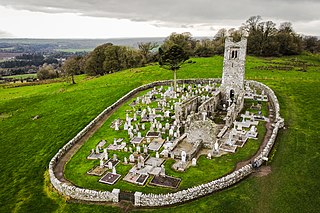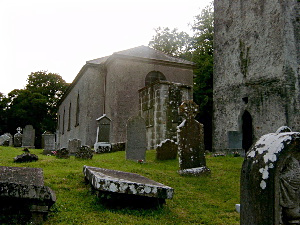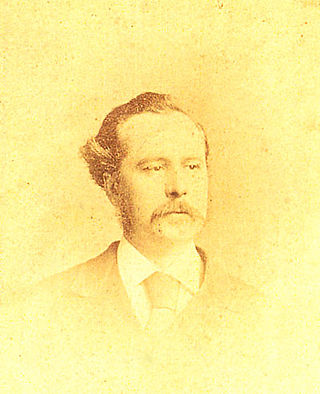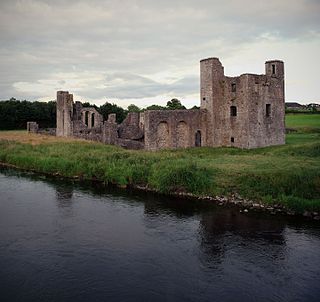
Slane is a village in County Meath, in Ireland. The village stands on a steep hillside on the left bank of the River Boyne at the intersection of the N2 and the N51. As of the 2022 census, Slane's population was 1,445. The village and surrounding area contains many historic sites dating back over 5,000 years. The village centre, as it is laid-out today, dates mainly from the 18th century. The village is in a townland and civil parish of the same name.

Ardbraccan is an ancient place of worship in County Meath, Ireland. It is the location of the former residence of the Roman Catholic, then, after the Reformation, the Church of Ireland Bishop of Meath. it was also a place of prominence in pre-Christian Pagan history. It is approximately 52 km from Dublin via the M3 Motorway, and 4 km from Navan. Ardbraccan is in a civil parish of the same name.

Trim is a town in County Meath, Ireland. It is situated on the River Boyne and, as of the 2022 census, had a population of 9,563. The town is in a civil parish of the same name.

Ferns is a historic town in north County Wexford, Ireland. It is 11 km (7 mi) north of Enniscorthy. The remains of Ferns Castle are in the centre of the town.
The Diocese of Meath is an Irish diocese which took its name after the ancient Kingdom of Meath. In the Roman Catholic Church it still exists as a separate diocese, but in the Church of Ireland it has been united with other dioceses.

The term Norman architecture is used to categorise styles of Romanesque architecture developed by the Normans in the various lands under their dominion or influence in the 11th and 12th centuries. In particular the term is traditionally used for English Romanesque architecture. The Normans introduced large numbers of castles and fortifications including Norman keeps, and at the same time monasteries, abbeys, churches and cathedrals, in a style characterised by the usual Romanesque rounded arches and especially massive proportions compared to other regional variations of the style.

The Abbey of St Mary is a ruined Benedictine abbey in York, England and a scheduled monument.

Skryne or Skreen is a village in County Meath, Ireland. On and around a hill between the N2 and N3 roads, it is 10 km south-east of the centre of Navan and 35 km north-west of the centre of Dublin. The village is on the far side of the Gabhra valley from the Hill of Tara. The Hill of Skryne is higher than the neighbouring Hill of Tara. Skreen gives its name to the surrounding barony, civil parish and townland.
Major William Cadogan (1601–1661), of Liscarton, County Meath, was born at Dunster, Somerset, to Henry Cadogan of Llanbetter, Pembrokeshire. His great-grandfather, Thomas Cadogan, of Dunster, claimed descent from the ancient princes of Wales. He was the father of the Dublin barrister Henry Cadogan and the grandfather of William Cadogan, 1st Earl Cadogan.

Edward Welby Pugin was an English architect, the eldest son of architect Augustus Welby Northmore Pugin and Louisa Barton and part of the Pugin & Pugin family of church architects. His father was an architect and designer of Neo-Gothic architecture, and after his death in 1852 Edward took up his practice. At the time of his own early death in 1875, Pugin had designed and completed more than one hundred Catholic churches.

The Archdiocese of Dublin is a Latin Church ecclesiastical territory or archdiocese of the Catholic Church located in the eastern part of Ireland. Its archepiscopal see includes the republic's capital city – Dublin. The cathedral church of the archdiocese is St Mary's Pro-Cathedral. Dublin was formally recognised as a metropolitan province in 1152 by the Synod of Kells. Its second archbishop, Lorcán Ua Tuathail, is also its patron saint.

St. Augustine Catholic Church, also called Olde St. Augustine's, is a historic Catholic church in Philadelphia, Pennsylvania, United States. Consecrated in 1848, the Palladian-style church was designed by Napoleon LeBrun. It is listed on the National Register of Historic Places.

Dunsany Castle, Dunsany, County Meath, Ireland is a modernised Anglo-Norman castle, started c. 1180 / 1181 by Hugh de Lacy, who also commissioned the original Killeen Castle, nearby, and the famous Trim Castle. It is one of Ireland's oldest homes in continuous occupation, possibly the longest occupied by a single family, having been held by the Cusack family and their descendants by marriage, the Plunketts, from foundation to the present day. The castle is surrounded by its demesne, the inner part of the formerly extensive Dunsany estate. The demesne holds a historic church, a walled garden, a stone farm complex, and an ice house, among other features, and is home to a wide range of fauna.

Donacarney is a village in County Meath, Ireland, close to Drogheda and the border with County Louth. It contains one church, two estates, two schools, and one pub. Although it includes the townlands of Donacarney Great and Donacarney Little, most locals would never use those terms in describing Donacarney. The remains of a late-medieval tower house are sited close to Donacarney Cross. It is described in the Down Survey (1654–56) as "an ould Castle". It appears in this state on a map of 1771. Blackhills Crescent, Donacarney, takes its name from the area known as the Black Hills or Black Hill Lands north of the crossroads and the castle, the old name of which was Croc a' Searra in Irish.

St. Mary's Church in Navan, County Meath is one of two churches that make up the modern-day Parish of Navan in the Diocese of Meath. It was opened in 1839.

Tristernagh Abbey, also known as the Priory of Kilbixy or Kilbisky, Tristernagh Priory, or the priory of the Blessed Virgin Mary of Tristernagh, is a ruined Augustinian monastery in the townland of Tristernagh in the barony of Kilbixy in County Westmeath, Ireland. It is situated on the shores of Lough Iron, about 3 kilometres (1.9 mi) north east of the village of Ballynacargy.

St. John's Priory is a medieval priory and hospital and National Monument located near Trim, County Meath, Ireland.

St. Mary's Abbey is a medieval monastery and National Monument located in Duleek, Ireland.


















